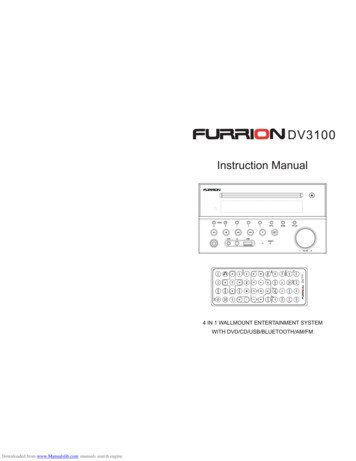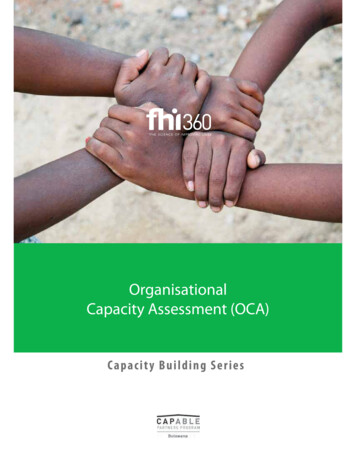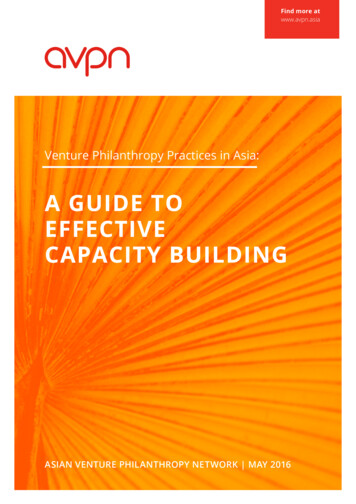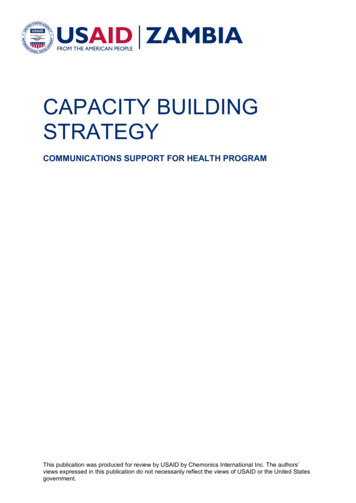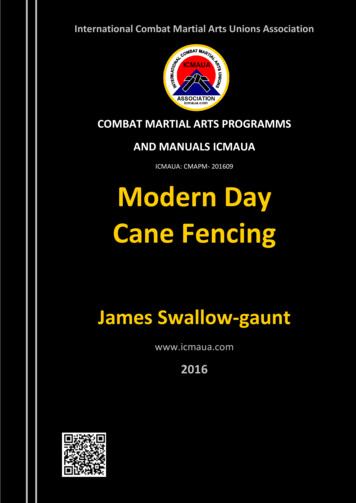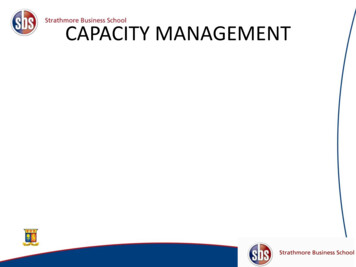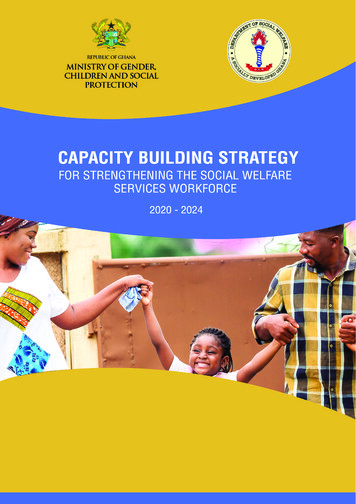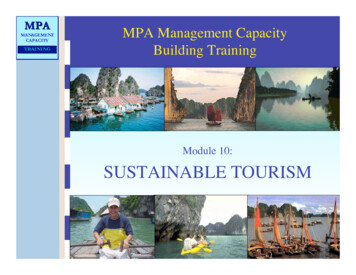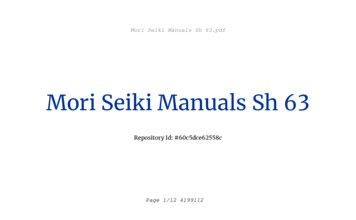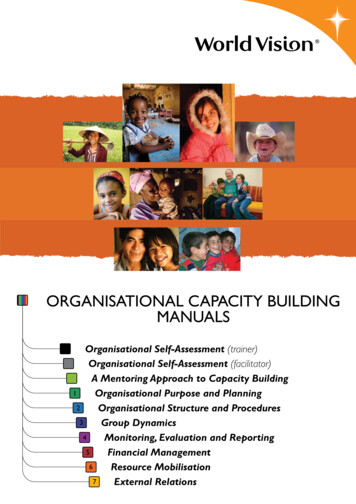
Transcription
ORGANISATIONAL CAPACITY BUILDINGMANUALSOrganisational Self-Assessment (trainer)Organisational Self-Assessment (facilitator)A Mentoring Approach to Capacity Building1Organisational Purpose and Planning2Organisational Structure and Procedures3Group Dynamics4Monitoring, Evaluation and Reporting5Financial Management6Resource Mobilisation7External Relations
Introduction to the Organisational Capacity BuildingManuals, Web Publication versionWelcome to the Web Publication of the Organisational CapacityBuilding Manuals! This presentation of these manuals isoptimised for online and computer-based viewing using AdobeReader. The books within this collection contain the same content as theirprinted counterparts, and follow the same pagination.This publication is not optimised for printing. To request a printed versionof these books, to request permission to print and use this publication, orfor any other information regarding this publication, please contact:World Vision InternationalCh. de la Tourella 6, 1209 – Geneva, Switzerlandemail: geneva@wvi.orgA few words regarding navigationIn this publication, it is possible to navigate from one page to the nextusing the usual Page Up / Page Down buttons, the Left and Right Arrowbuttons, or by clicking the Previous Page / Next Page icons. However,it should be pointed out that directly entered page numbers are not likelyto take you to intended destinations, as many page numbers are reiteratedfrom one booklet to the next and cannot be distinguished from one another.Rather, for navigating to different sections, two useful methods are via thePages tool and the Bookmarks tool, each of which can be found at the sideof the viewport. (If these tools are absent, they may be hidden, or you maybe using an older version of Adobe Reader. If you have access to the Internet,you may wish to visit adobe.com to download a current version.)The Pages tool provides a visual means of navigation. When the Pages iconis selected, a thumbnail icon of each page in the publication is produced.These icons can then be selected to navigate to specific pages.The Bookmarks tool provides a topical means of navigation. When theBookmarks icon is selected, a topically organised menu is produced. Topicscan be collapsed by clicking on the ‘ - ’ icons, and expanded by clicking onthe ‘ ’ icons. Topics can be selected to navigate to the given index or pagethat reflects the topic. The bookmarks are also helpful for getting a sense ofthe general structure and sectional organisation of the manuals.For more comfortable reading of sideways-formatted pages, the view can berotated page by pressing Ctrl Shift “ ” and Ctrl Shift “-”.
Part 1: Trainer’s Manual for f-Assessment
World Vision is a Christian relief, development and advocacyorganisation dedicated to working with children, families andcommunities to overcome poverty and injustice.As followers of Jesus, World Vision is dedicated to workingwith the world’s most vulnerable people. World Vision servesall people regardless of religion, race, ethnicity or gender. 2008 by World Vision InternationalAll rights reserved. No portion of this publication may be reproduced in any form,except for brief excerpts in reviews, without prior permission of the publisher.Published by World Vision International, Ch. de la Tourella 6, 1209 – Geneva, Switzerlandemail: geneva@wvi.orgPrinted in Zimbabwe.author:Michele Gaudraultcover design: Ian and Lara Pugh, Blue Apple Designlayout and illustration: Stan Watt, Eta Carina DesignOCB manual development was coordinated by:Models of Learning team, World Vision Hope Initiativethe printing and distribution of this manual was made possiblewith the support of World Vision Germany
World VisionTrainer’s Manual for Organisational Self-AssessmentTrainer’s Manual ion . . . . . . . . . . . . . . . . . . . . . . . . . . . . . . . . . . . . . . . . . . . . . . . . . . . . . . . . . .4Sample Training Agenda . . . . . . . . . . . . . . . . . . . . . . . . . . . . . . . . . . . . . . . . . . . . . . 5Outline of 5-Day Training Curriculum:Day 1: AM, PM:Introduction to Participatory Methodologies. . . . . . . . . . . . . . 7Day 2: AM, PM:Introduction to Appreciative Inquiry, Overview of OCB Process . . 17Day 3: AM, PM:Internal Organisational Self-Assessment: Steps 1-3. . . . . . . . . 27Day 4: AM:Internal Organisational Self-Assessment: Step 4 . . . . . . . . . . . 35Day 4: PM:Practical Facilitation. .Day 5: AM:Practical Facilitation (continued)Day 5: PM:Wrap Up, Test, Closing. . . . . . . . . . . . . . . . . . . . . . . . . . . . . . . . . 41Contents. . . . . . . . . . . . . . . . . . . . . . . . . . . . . . . . . .39
World VisionTrainer’s Manual for Organisational Self-AssessmentIntroductionThis Trainer’s Manual is a companion guide to World Vision’sFacilitator’s Manual for Organisational Self-Assessment, which forms Part1 of World Vision’s Organisational Capacity Building program. 1The Trainer’s Manual is meant to be used by experienced Trainers taskedwith training the Facilitators who will, in turn, carry out the OrganisationalSelf-Assessment (OSA) with CBOs. The training curriculum outlined herewill ideally be co-facilitated by three experienced Trainers, as this will allowfor a division into groups on the penultimate day for practical facilitationpractice. If such co-training is not possible, the Trainer will need to workout alternative arrangements for that section of the training agendaThe target recipients for this training are World Vision Facilitatorstasked with carrying out the Organisational Self-Assessment process incommunities. These should be staff with the front-line responsibility for fieldimplementation. Senior staff (non-implementers) may also participate in thetraining, but on the understanding that they will be receiving more detailabout the OSA process than they in fact will require as non-implementers.The sample training program outlined in this Manual requires 5 days tocomplete. The sequence of activities in this 5-day training has been pilotedand refined by World Vision Trainers in various countries in Sub-SaharanAfrica and is judged to be appropriate to this context. Nevertheless, WorldVision’s Organisational Capacity Building program in its entirety is a work inprogress. All feedback and comments are most welcome and may be sent to:Stefan germann@wvi.org1 IntroductionA sepa rate Tra iner’s Ma nua l to accompa ny Pa r t II: Facilitator’s Manual to Organisational Capacit yBuilding is still under construction.
World VisionTrainer’s Manual for Organisational Self-AssessmentSample Training AgendaDay 1: Introduction to Participatory FacilitationTime8:00 - 8:308:30 - 9:159:15 - 10:0010:00 - 10:2010:20 - 10:3010:30 - 10:4510:45 - 11:1511:15 - 11:3011:30 - 12:1512:15 - 13:1513:15 - 14:1514:15 - 15:00ActivityDevotionsPresentation GameBrainstorm GameBreakAgendaTraining ObjectivesLogistics and Training RulesBackground to ParticipationBasic Principle #1LunchFacilitation TechniquesDistribute OCB Guide, give homewoorkFacilitatorDay 2: Introduction to Appreciative Inquiry, Overview of OCB ProcessTime8:00 - 8:308:30 - 9:009:00 - 10:0010:00 - 10:2010:20 - 12:0012:00 - 12:3012:30 - 13:3013:30 - 14:3014:30 - 15:1515:15 - 15:4515:45 - 16:30Sample Training AgendaActivityFacilitatorDevotionsGroup divisions, explain Thurs / Fri work and scoringA Diagram of Appreciative InquiryBreakPractice with AI ActivitiesFeedback on AI FacilitationLunchOverview: What is Capacity Building; What is OCBIntro to “Menu” of Capacity AreasBreakThe Importance of the Capacity Areas
World VisionTrainer’s Manual for Organisational Self-AssessmentDay 3: Internal Organisational Self-Assessment: Steps 1-3Time8:00 - 8:308:30 - 9:009:00 - 9:459:45 - 10:0010:00 - 10:2010:20 - 10:4510:45 - 11:4511:45 - 12:1512:15 - 13:1513:15 - 13:3013:30 - 14:1514:15 - 15:0015:00 - 15:2015:20 - 15:4515:45 - 16:30ActivityDevotionsHomework QuizPowerpoint, Intro 5 Steps, Identify Partic. MethodsIntro / Review OSA Step 1BreakGroup Work – StorytellingPlenary: Sharing Stories, Extracting ThemesCreating the Organisational “Tree”LunchIntro / Review OSA Step 2Group Work - VisioningPlenary Summary – VisioningBreakIntro / Review OSA Step 3Plenary: OSA Step 3FacilitatorDay 4: Internal Organisational Self-Assessment: Step 4, Practical FacilitationTime8:00 - 8:308:30 - 9:009:00 - 10:0010:00 - 10:2010:20 - 11:3011:30 - 12:0012:00 - 13:0013:00 - 16:30ActivityDevotionsIntro / Review OSA Step 4Group Work: Scoring the Capacity AreasBreakGroup Work: Graphing the ScoresPreparations / Logistics for Afternoon SessionLunchPractical Facilitation in Groups with Scoring: Part 1FacilitatorDay 5: Practical Facilitation, Wrap UpTime8:00 - 8:308:30 - 12:0012:00 - 13:0013:00 - 14:0014:00 - 15:0015:00 - 15:2015:20 - 16:0016:00 - 17:00 Sample Training AgendaActivityDevotionsPractical Facilitation in Groups with Scoring: Part 2LunchPlenary Feedback on Practical Facilitation: TipsExperiences from other CountriesBreakTestAction PlansFacilitator
World VisionTrainer’s Manual for Organisational Self-AssessmentOutline of 5-Day Training CurriculumDay 1: Introduction to Participatory MethodologiesContentsActivity 1:Presentation Game. . . . . . . . . . . . . . . . . . . . . . . . . . . . . . . . . . . . . . 8Activity 2:Background Information . . . . . . . . . . . . . . . . . . . . . . . . . . . . . . . . . 9Activity 3:Course Objectives . . . . . . . . . . . . . . . . . . . . . . . . . . . . . . . . . . . . . . 11Activity 4:Training Ground Rules. . . . . . . . . . . . . . . . . . . . . . . . . . . . . . . . . . . 12Activity 5:Basic Principle: The Need for Participation. .Activity 6:Facilitation Techniques. . . . . . . . . . . . . . . . . . . . . . . . . . . . . . . . . . . 15Day 1: Introduction to Participatory Methodologies. . . . . . . . . . . . . .13
World VisionTrainer’s Manual for Organisational Self-AssessmentActivity One:Preparation:NoneHandouts:Handout 1Materials:NoneTime:30 - 40 minutesPresentation GameInstructions1. Distribute Handout 1 to all participants. Inform participants thatthey should fill out everything except for “Name” and “District”. For“Birthday” they do not need to write the year; only the month and day.For “Something interesting about me”, you may provide an examplesuch as “I am a good cook”.2. When all participants have filled out their forms, collect the forms andthen redistribute them randomly. If a participant receives his / her ownpaper, he / she should return it to you for a new one.3. Participants must now circulate and ask questions to other participantsuntil they find the owner of the paper they have received. Participantsshould arrange themselves in a circle such that each person is standingnext to his / her partner. For example, if participant A has the paper ofparticipant B, and B has the paper of C, and C has the paper of D, andD has the paper of A, a circle will be formed in the order A-B-C-D-A.It will take participants from between 10-15 minutes to find the ownersof the papers and to arrange themselves into a circle.4. Now ask each participant to introduce his / her partner, providing allinformation except for the “Three things I know about participatorymethodologies” (This is information for you, the Trainer.) After eachperson has presented, do a verification check to see if the otherparticipants have remembered the information. Clap for each person.5. Collect all papers at the end for your own records. Day 1: Introduction to Participatory Methodologies
World VisionTrainer’s Manual for Organisational Self-AssessmentActivity Two:Background Alarm clock, flip-chart paper, markers, sticky gum (Bostik)Time:30 - 45 minutesInstructions Divide participants into three groups. (Note: If you have more than threegroups the activity becomes too unwieldy.) Each group should give itself ateam name. Give each team a sheet of flip chart paper and a marker. Explain to the teams that you will be giving them a topic. You may give theexample: “Cooking”. (Explain that this is only an example and not the topicthat the groups will be working with.) Each team must come up with asmany words as possible related to the topic in two minutes and write thewords quickly. Examples might include “pots, pans, oven, eggs”, etc. Explainto the teams that if they have a word that the other teams do not have, theirteam will win two points. If they have a word that one other team has, thetwo teams with that word will each win one point. If all three teams havethe same word, no team wins a point. The teams must brainstorm quietlyso that the other teams do not hear their words. Make sure that all teamsunderstand the rules. Do not give the topic until you are ready to begin. Set the alarm clock for exactly two minutes. Right at the beginning ofthe two minutes give the teams the topic: “Football” (Soccer). This isusually a very easy and popular topic. The teams have two minutes tobrainstorm as many words as possible related to football. When the alarm goes off, all teams must put down their markers. Eachteam should send one member to another team to act as a “TruthVerifier”, making sure that the words the team announces are in factwritten on the paper. Ask the first team for their first word. Note thepoints on the flip chart accordingly (two points for a word that no otherteam has, one point for each of two teams if two of the three teamshave the same word, no points if all three teams have the same word).Ask the second team for their first word and note the points on the flipchart accordingly. Continue around the teams in this way until all teamshave exhausted their words. You should do this quickly and not allow fortoo much argument or discussion. Make “executive decisions” yourself asto whether or not a word is acceptable. You should accept most wordsunless they are wildly unrelated to the topic. Keep the pace loud and fast.Day 1: Introduction to Participatory Methodologies
World VisionTrainer’s Manual for Organisational Self-Assessment After this first round, determine which team is in the lead. Explain to theteams that the game is not finished, however! Tell them to get ready for asecond round. “Truth Verifiers” should return to their own teams. Whenall teams are ready and you have set the alarm for two minutes, give thesecond topic: “Participatory Methodologies”. The teams should onceagain brainstorm as many words as possible related to this topic. Whenthe two minutes are up, score the teams in the same way as before, andcome up with the final winner of the game. During the break you should copy all the brainstormed words fromthe second round in neat handwriting onto one sheet of flip chartpaper and post it on the wall. Draw the participants’ attention to thefact that they already demonstrate a good deal of knowledge aboutparticipatory methodologies!10Day 1: Introduction to Participatory Methodologies
World VisionTrainer’s Manual for Organisational Self-AssessmentActivity Three:Preparation:NoneHandouts:Handout 2Materials:NoneTime:15 minutesCourse ObjectivesInstructions Distribute Handout 2 to the participants and review the trainingobjectives with them. Answer any questions that they may have.Day 1: Introduction to Participatory Methodologies11
World VisionTrainer’s Manual for Organisational Self-AssessmentActivity Four:Training Ground RulesPreparation:NoneHandouts:NoneMaterials:Flip chart paper, markers, sticky gum (Bostik)Time:20 minutesInstructions Tell the participants that they must come up with “Ground Rules” for thetraining week. They should write the rules on flip chart paper and postthem on the wall for the duration of the training. If the participants do not come up with the following points themselves,you should add them: Cell phones must be switched to silent mode No sending sms’s during the training; only during breaks No use of laptops during the training. (Laptops will not be needed.Participants can take hand-written notes and they will bereceiving handouts.)12Day 1: Introduction to Participatory Methodologies
World VisionTrainer’s Manual for Organisational Self-AssessmentActivity Five:Basic Principle:The Need for ParticipationPreparation:Speak to a volunteer ahead of time who will lead the “karate” activityHandouts:NoneMaterials:Flip chart paper, markers, sticky gum (Bostik)Time:30 - 45 minutesInstructions Draw three concentric circles on the flip chart, as below, and explainto the participants that these circles represent “Basic Principle no. 1”,without telling them yet what this principle is: Think of some sort of sporting action that you know how to do. Thiscould be a golf swing, a swimming breast stroke, a football kick, a dancemove, a volleyball hit, etc. You will go through three steps in “teaching”the class how to carry out this action. First, try to explain to the grouphow to carry out your action without demonstrating the action at all.That is to say, explain through words only, do not demonstrate. Second,repeat your explanation but now accompany it with a demonstration ofwhat you are talking about. (Show the group your golf swing, or yourswimming stroke, or your dance move, etc.). Finally, ask the group tostand up and to practice the action with you. Now call your volunteer up and have him / her go through the same threesteps with reference to a “karate chop”. When it is time for the groupto stand up and demonstrate, the karate chop should be as dramatic andenergetic as possible!Day 1: Introduction to Participatory Methodologies13
World VisionTrainer’s Manual for Organisational Self-Assessment While this is a simple example, it makes the point that we learn muchbetter when we are actively involved in the learning. While the percentagesmay not be absolute, you may explain to the group that it is commonlyrecognised that we retain in the long run approximately 20% of what wehear, 40% of what we see and hear, and 80% of what we actively learn forourselves. Indicate these percentages on the drawing on the flip chart:20%40%80% Explain to the group that you showed them an example of learning a skill,but that the same principle applies when learning new information. The implication is that we must always make an effort to facilitate theactive participation of our learners in the learning process.14Day 1: Introduction to Participatory Methodologies
World VisionTrainer’s Manual for Organisational Self-AssessmentActivity Six:Facilitation lip chart paper, markers, sticky gum (Bostik)Time:30 - 45 minutesInstructions Ask the group to brainstorm in plenary what they think some importantfacilitation techniques are. You should write their ideas on a flip chart, orask a volunteer to do so. Allow sufficient time to develop a good list andto discuss the group’s ideas. When the group has exhausted their ideas, explain to the participantsthat later in the week they will be assessed on some facilitationtechniques. It is likely that the group will have already come up with manyof the techniques that you will be assessing, but if any are missing fromthe list, you should add them:Facilitator Style Speak loudlyDynamismSmileBody languageEmpathyFacilitator Skills Promote participation Verify understandingContent / Message Synthesise ideas Content understood and transmittedDay 1: Introduction to Participatory Methodologies15
World VisionDay 2:Trainer’s Manual for Organisational Self-AssessmentIntroduction to Appreciative Inquiry,Overview of OCB ProcessContentsActivity 1:Visual Depiction . .Activity 2:The Assumptions of Appreciative Inquiry. . . . . . . . . . . . . . . . . . 21Activity 3:Practicing with AI Activities . . . . . . . . . . . . . . . . . . . . . . . . . . . . . . 22Activity 4:Introduction to Capacity Building. . . . . . . . . . . . . . . . . . . . . . . . . 23Activity 5:Introduction to the “Menu” of Capacity Areas. . . . . . . . . . . . . 24Activity 6:The Importance of the Capacity Areas. . . . . . . . . . . . . . . . . . . . 26. . . . . . . . . . . . . . . . . . . . . . . . . . . . . . . . . . . . . .Day 2: Introduction to Appreciative Inquiry, Overview of OCB Process1817
World VisionTrainer’s Manual for Organisational Self-AssessmentActivity One:Visual ip chart paper, markers, sticky gum (Bostik)Time:1 hourInstructions Refer to the visual depiction on page 20. This is the visual you will drawon the flip chart. Explain to the participants that the visual represents3 different scenarios. Scenario 1 represents the “traditional” approach to development andto organisational evaluation. In this drawing, the bold arrows representthe “distance” that an organisation or group has already traveled, or thestrengths that they demonstrate, or the accomplishments that they haveachieved. The dotted lines represent all that has yet to be achieved withinthe organisation; or that which is missing. In traditional organisationalevaluation, an external evaluator would arrive with a set of indicators(represented by the X’s), representing one standard, or one outcome,that all organisations were expected to achieve. The focus of theevaluation would be on measuring the extent to which the organisationdemonstrated – or not – those indicators, and the main emphasis wouldbe placed on that which was lacking or missing. In this scenario, the externalevaluator was the “expert” and imposed his ideas on the organisation,always indicating to the organisation the gaps that needed to be filledin order to reach the ideal outcome, as measured against the predetermined indicators. You should explain all this to the participants andexplain that this traditional form of interaction with a group – completely“top-down” – is no longer considered to be the best way to work. Scenario 2 represents a 180 degree reversal of Scenario 1. Explain tothe group that there was a time when development thinking seemed tohave moved to this opposite extreme. In this scenario, the developmentworker believes that whatever the group believes and wants is valid, andthat the group can move in whatever direction it wants. The developmentworker in this case simply stands back (with “arms folded”) and doesnot intervene with opinions and ideas. An organisational evaluation, inthis scenario, would consist of the organisation talking about how much18Day 2: Introduction to Appreciative Inquiry, Overview of OCB Process
World VisionTrainer’s Manual for Organisational Self-Assessmentit has achieved and where it wants to go, without any input from thedevelopment worker at all. You should explain to the participants thatthis scenario is also not entirely satisfactory, as it presupposes that you(the facilitator, the development worker) have nothing to offer at all, andthat your interaction with the group does not and should not affect orinfluence the group in any way. This extreme way of working does notallow any space for your input into the group’s development. Instead, you will want to explain to the participants that we should beaspiring to Scenario 3. In this scenario the facilitator is “walking alongwith” the group members and assisting them with ideas and suggestions,through dialogue and mutual sharing. The final “outcome” of the groupis unknown (represented by ?’s), but the facilitator and the group willtogether provide input as to what this outcome might be. Organisational self-assessment in this scenario proceeds in a specificsequence. In the first step, the facilitator will encourage the groupto recognise and appreciate that which is already working well in theorganisation; its strengths and achievements. This is represented by thebold arrows, showing the “journey already traveled”, and indicated bythe number 1. This is the main difference between Appreciative Inquiryand other approaches! Appreciative Inquiry insists that the organisationlook first at that which is already working well, in order to move forwardbased on strengths that the organisation already has. Step 2 then involves dreaming and visualizing a preferred future outcome– represented by the ?’s (as the future is not yet entirely known) andindicated by the number 2. Finally in Step 3 the organisation identifiesareas in which it will need to grow in order to achieve its vision forthe future. This is represented by the dotted lines and indicated by thenumber 3. This is a completely different approach from approaches thatlook only at that which the organisation is lacking, or its weaknessesor gaps ! In Appreciative Inquiry the idea is to begin with the positive,look to the future, and identify areas for further improvement. It isOpportunity-Based, as opposed to Problem-Based. Go through the visual diagrams with the group and try to make all ofthese points. You should allow an hour for this activity to ensure thatthere is ample time for questions and discussion.Day 2: Introduction to Appreciative Inquiry, Overview of OCB Process19
World VisionTrainer’s Manual for Organisational Self-AssessmentScenario 1:Scenario 2:Scenario 3:2013Day 2: Introduction to Appreciative Inquiry, Overview of OCB Process2
World VisionTrainer’s Manual for Organisational Self-AssessmentActivity Two:The Assumptions of Appreciative InquiryPreparation:NoneHandouts:Handout 3Materials:Flip chart paper, markers, sticky gum (Bostik)Time:30 minutesInstructions Divide the participants into groups of three or four members. DistributeHandout 3 to the groups and tell them to discuss the assumptionstogether. Ask each participant to decide which assumption is his / herfavorite – which assumption “speaks to them” – and to explain theirreasons to the other members of their small group. Following the group work, return to plenary and ask for volunteers toshare their favorite assumption, telling the plenary what they likeabout the assumption and what they understand by it. Allow time forfive or six volunteers to share their ideas. Answer any questions thegroup may have.Day 2: Introduction to Appreciative Inquiry, Overview of OCB Process21
World VisionTrainer’s Manual for Organisational Self-AssessmentActivity Three:Practicing with AI ActivitiesPreparation:NoneHandouts:Handout 4, cut into sections for each groupMaterials:A glass, water, flip chart paper, markers, sticky gum (Bostik)Time:1 and ½ hoursInstructions Divide the participants into five groups and give each group one of theactivities from Handout 4. The groups should take time to read andunderstand the activity and decide how they want to facilitate the activityin plenary. Note that some of the activities will require the participationof all the members of the small groups (i.e. the two role plays), whileother activities might only require the facilitation of one person (such as“the black dot”, “the glass of water” and “positive characteristics”.) After the small groups have had time to practice, each group will facilitateits activity in turn. The groups with role plays will perform the role plays,while the remaining groups will facilitate their activities as if the classwere a community CBO. After each activity is presented, you should help the participantsunderstand the main message of the activity. In all cases the messagerelates to focusing on the positive, not on that which is missing! We have achoice of what we choose to focus on, such as in the example of the glassof water – is it “half empty” or “half full” – and we can make the choiceto focus on the positive (“half full”). You should also use the opportunity to begin to give the participantsfeedback on their facilitation skills. As groups facilitate their activities,let the facilitators know if they are speaking loudly, smiling, beingdynamic, showing empathy to the class, promoting participation, verifyingunderstanding, and if the main message was effectively summarised by theend of the activity. You should also draw the participants’ attention to those factors thatmake a role play effective, to include all actors speaking loudly and clearly,not turning their backs to the audience, speaking one person at a time,and other role play tips that you and the participants may come up with.22Day 2: Introduction to Appreciative Inquiry, Overview of OCB Process
World VisionTrainer’s Manual for Organisational Self-AssessmentActivity Four:Introduction to Capacity BuildingPreparation: Powerpoint overview (optional)Handouts: Handout 5Materials: Powerpoint projector (optional), flip chart paper, markers,sticky gum (Bostik)Time: 1 and ½ hoursInstructions If you have prepared a powerpoint presentation with an overview of theOCB process you may give this presentation to the group. After the presentation, divide the participants into 3 or 4 small groupsand give the groups the following two questions to answer: What is capacity building? Give 3 examples of possible capacity building interventions Give the groups time to work, and to write their answers on flip chartpaper. Then return to plenary and have each group present their work. Consolidate the activity by making sure that participants understand thefollowing points: Capacity building is more than just training! Capacity building is a process, not a one-off event. Capacity build
4 World Vision Trainer's Manual for Organisational Self-Assessment Introduction Introduction T his Trainer's Manual is a companion guide to World Vision's Facilitator's Manual for Organisational Self-Assessment, which forms Part 1 of World Vision's Organisational Capacity Building program.
